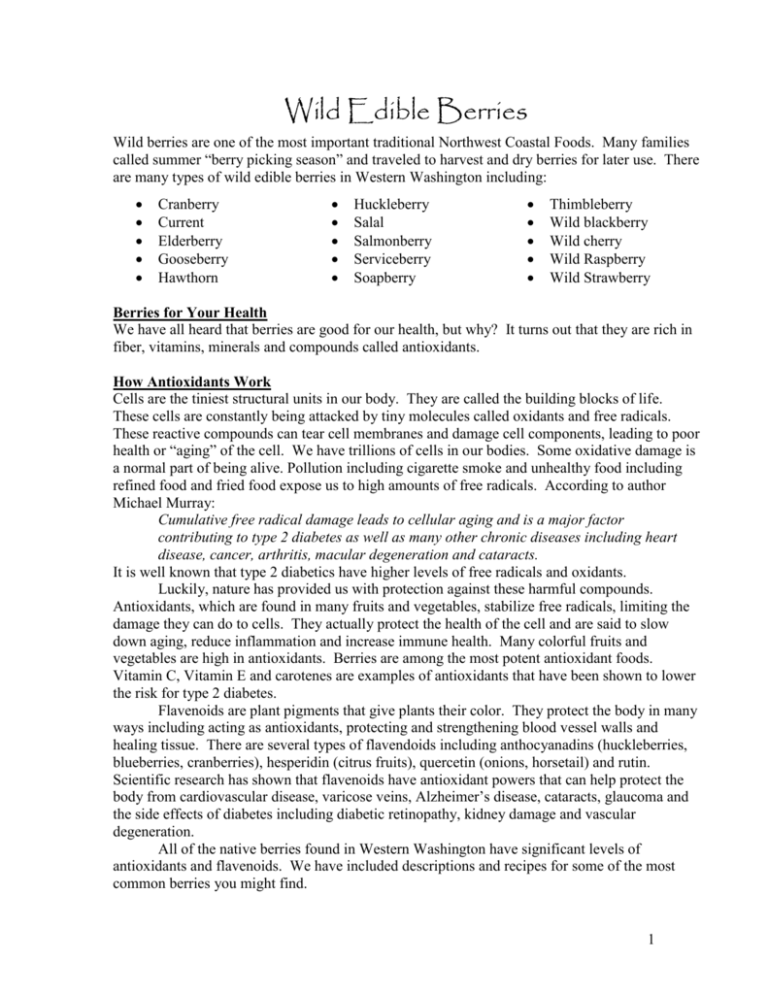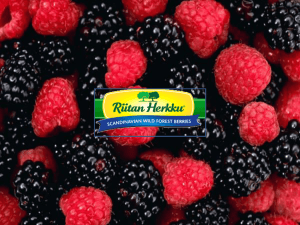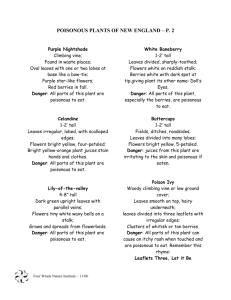Wild Edible Berries - The School of Traditional Western Herbalism
advertisement

Wild Edible Berries Wild berries are one of the most important traditional Northwest Coastal Foods. Many families called summer “berry picking season” and traveled to harvest and dry berries for later use. There are many types of wild edible berries in Western Washington including: Cranberry Current Elderberry Gooseberry Hawthorn Huckleberry Salal Salmonberry Serviceberry Soapberry Thimbleberry Wild blackberry Wild cherry Wild Raspberry Wild Strawberry Berries for Your Health We have all heard that berries are good for our health, but why? It turns out that they are rich in fiber, vitamins, minerals and compounds called antioxidants. How Antioxidants Work Cells are the tiniest structural units in our body. They are called the building blocks of life. These cells are constantly being attacked by tiny molecules called oxidants and free radicals. These reactive compounds can tear cell membranes and damage cell components, leading to poor health or “aging” of the cell. We have trillions of cells in our bodies. Some oxidative damage is a normal part of being alive. Pollution including cigarette smoke and unhealthy food including refined food and fried food expose us to high amounts of free radicals. According to author Michael Murray: Cumulative free radical damage leads to cellular aging and is a major factor contributing to type 2 diabetes as well as many other chronic diseases including heart disease, cancer, arthritis, macular degeneration and cataracts. It is well known that type 2 diabetics have higher levels of free radicals and oxidants. Luckily, nature has provided us with protection against these harmful compounds. Antioxidants, which are found in many fruits and vegetables, stabilize free radicals, limiting the damage they can do to cells. They actually protect the health of the cell and are said to slow down aging, reduce inflammation and increase immune health. Many colorful fruits and vegetables are high in antioxidants. Berries are among the most potent antioxidant foods. Vitamin C, Vitamin E and carotenes are examples of antioxidants that have been shown to lower the risk for type 2 diabetes. Flavenoids are plant pigments that give plants their color. They protect the body in many ways including acting as antioxidants, protecting and strengthening blood vessel walls and healing tissue. There are several types of flavendoids including anthocyanadins (huckleberries, blueberries, cranberries), hesperidin (citrus fruits), quercetin (onions, horsetail) and rutin. Scientific research has shown that flavenoids have antioxidant powers that can help protect the body from cardiovascular disease, varicose veins, Alzheimer’s disease, cataracts, glaucoma and the side effects of diabetes including diabetic retinopathy, kidney damage and vascular degeneration. All of the native berries found in Western Washington have significant levels of antioxidants and flavenoids. We have included descriptions and recipes for some of the most common berries you might find. 1 Cranberry Oxycoccus species. Cranberries are the jewels of the northwest coastal bogs. These tiny plants grow in the moss and produce round, ruby-colored berries in late summer through winter. The time to gather them is usually in autumn after the first frost. Cranberries can be eaten fresh but their flavor is greatly improved with cooking and sweetening. If you have ever had unsweetened cranberry juice, you know how it can make your face pucker up. Cranberries have long been used as a food and medicine. The berries were traditionally stored in damp moss through the winter and stayed fresh through spring. They were also picked green and stored in boxes or baskets until they turned soft and brown. In Discovering Wild Plants Janice Schofield says that the Inupiat feed cranberries in seal oil to those with a poor appetite and gall bladder problems. This makes perfect sense, since bitter compounds in plants stimulate the secretion of digestive juices Many people drink cranberry juice for its ability to prevent bladder and urinary tract infections. Most cranberry juice on the market is heavily sweetened. Sugar weakens immune function, so try to find unsweetened or lightly sweetened cranberry juice. You can add half apple juice to help the flavor. At least three cups a day are recommended for preventing urinary tract and bladder infections. Blueberry and huckleberry juice can be used in the same way. Cranberry is a favorite relish for accompanying turkey and other meats. It is also excellent in salad dressing, deserts, breads, jams and jellies. The berries are high in pectin, so when you cook them, they naturally become thick. Cranberry Rosehip Relish 1 12 oz. bag of cranberries 1 cup fresh rosehips or 1/2 cup of dried rosehips (cleaned, seeds removed) The juice of 1 orange Agave nectar, honey or sugar added to desired sweetness 2 tablespoons lemon juice In a medium-sized pan gently heat cranberries, rosehips, orange juice and lemon juice until the cranberries and rosehips are soft and cooked. Add more water if necessary. Add agave or other sweetener to desired sweetness. Let the relish cool before serving it and keep refrigerated for up to several weeks. Huckleberry Vaccinium species What is better than wandering through the woods and finding a bush covered in ripe huckleberries? There are more than 20 species of huckleberries in the Northwest, which range from the coast to the high mountains. Huckleberries come in many sizes. Dwarf wartelberry is a mere six inches tall and is covered in tiny red berries that would satisfy a mouse, while the bigger mountain blueberries and huckleberries are large enough for bear to gorge on and actually get full. Berry colors range from orangish-red to purple to deep blue-black. The only difference 2 between huckleberries and blueberries is that huckleberries have a stronger flavor. They are the same genus botanically. Many types of huckleberries were traditionally harvested with combs made of wood. This device would easily strip the fruit from the bushes without damaging them. Techniques including burning and pruning have been used to increase huckleberry productivity. If you go into fields where people have carefully harvested and maintained the bushes, you will find that the berries are larger and more abundant. Huckleberries are one of the most important traditional foods and also one of the healthiest. They may be one of the reasons that many Native elders lived to be over 100 years old. They are considered an anti-aging food and are even being made into dietary supplements. Antioxidants in the plant protect body tissue from “free radicals” in cells that cause damage. They prevent inflammation and increase tissue strength. One of the easiest ways to make berries a regular part of your diet is by using frozen berries. If you do not gather enough from your own bushes, you can buy them frozen in most stores throughout the year. They are relatively inexpensive to buy in bulk at food coops. You can add them to hot cereal, sprinkle them on cold cereal, or put them over ice cream. The recommended daily amount for health benefits is 1/2 cup a day. Huckleberry smoothie In a blender place: 2 bananas 1/2 cup frozen blueberries or huckleberries 2 cups water or juice (orange, apple, etc.) 1/2 cup yogurt (optional) 1/2 teaspoon cinnamon A few drops vanilla extract Blend until smooth and pour in glasses. Serves 2. Cinnamon and blueberries are especially helpful for diabetes prevention and treatment. Huckleberries and Blueberries for Diabetics –Blueberries and huckleberries do not raise blood sugar and are an important food for pre-diabetics and diabetics. They are high in antioxidants which help protect the body from the effects of high blood sugar including diabetic retinopathies, kidney damage and poor tissue healing. Recent research suggests that blueberries (and huckleberries) also lower cholesterol and help to prevent heart disease, cancer and bladder or urinary tract infections. They are helpful for the heart and for preventing or treating varicose veins and hemorrhoids. Salal Gaultheria shallon 3 Salal is one of our most common and most overlooked berries. It grows in lush thickets under open evergreen forests or in sunny areas where there is moisture and good drainage. The leaves are thick, dark green on top and noticeably waxy. Spring flowers look like little white bells (sticky and slightly hairy), and the berries are a blue-black when ripe. Salal berries are ready between August and October, depending on elevation and weather conditions. They vary from delicious to bland and boring, depending on their soil and amount of sun. Taste the berries before you gather them, and if they do not suit you, try traveling to a different bush a little ways away. Salal was a common traditional food. The berries were traditionally mashed, dried into cakes and then stored and eaten in the winter months. Sometimes the berries were mixed with dried meat and traditional oils. The cakes were dried on cedar boards or skunk cabbage leaves (also called Indian wax paper). Many people preferred to rehydrate the cakes in water, then dip them into seal, whale or eulachon oil. Salal Fruit Leather Gather berries in late summer to early fall when they are sweet and tasty. Clean and rinse if necessary. 3 quarts of berries makes about 1 cookie sheet of fruit leather. Place berries in a blender with 1/3 cup honey to sweeten and the juice of one fresh lemon to bring out the flavor. Fit wax paper over a cookie sheet with sides. Pour blended berries onto the sheet and use a spatula to smooth them out to an even consistency of about a quarter inch. The berries can be dried traditionally in the sun or in the oven. Sun drying: If it is hot and dry, place the pan in the full sun, preferably in a windy spot. If there are flies or bugs, you can put cheesecloth over the berries. It will probably take 2-4 days to dry completely, so bring the berries in at night to prevent them from gathering dew. After the berries are mostly dried, lay another piece of wax paper over the berries and carefully turn them over. Peel the old wax paper off and let the other side dry out. When it seems the consistency of fruit leather, cut the berry sheet into strips and store in plastic bags to prevent it from drying out completely. You can also make round berry cakes and dry them on skunk cabbage leaves, which works like wax paper. This is the traditional method. Oven method: Place the berries in the oven on the lowest temperature (usually about 170 degrees) and leave the oven cracked so that water can evaporate off the berries. When the berries are mostly dry (6-8 hours) place another piece of wax paper over the berries and flip them over. Carefully peel off the wax paper and continue drying. If you have to leave, simply turn your oven off and place the berries in a warm spot in the house with cheesecloth or a paper towel over them. Continue drying as you can. Variations: You can make fruit leather out of a variety of berries. The key is to use berries that are low in water content. Good choices are thimbleberry, blueberry and huckleberry. Salmonberry Rubus spectabilis Salmonberries are some of the earliest berries of spring. Their bright pink flowers add a first splash of color to the forest after winter. In April through June succulent orange to rubycolored berries appear. Their taste varies according to where they grow so taste test some to find 4 the bushes that are most delicious. Salmonberry forms dense thickets in generally wet forested areas. It grows as high as nine feet tall with brown stems that are covered in thorns and leaves resembling the raspberry plant. Families in some tribal communities once owned salmonberry patches. After harvesting from their patch, the family might give a community feast, then open the area for picking to anyone. Salmonberries are especially juicy and do not dry or preserve well. They are usually eaten fresh. Soapberry Shepherdia Canadensis Soapberry or soopollalie got its name because it contains compounds called saponins that lather like soap. This is the plant of the famous Indian ice cream. This confection does not taste like ice cream, and it does not necessarily look like it either. When the berries are whipped, they make a foamy dessert that resembles light pink whipping cream. The berries are extremely bitter and these days most people mix them with sugar. Many people say Indian ice cream is an acquired taste. If you do not like it the first time, try it several times, and you may find you begin to enjoy it. Skokomish elder Bruce Miller talked about the traditional way of eating Indian ice cream as a palate cleanser between courses at feasts. Special wooden bowls and spoons were used to eat this delicacy. It was considered a party food. Soapberries are considered such an important fruit to coastal people that many families who did not have them in their area traded for them. Indian Ice Cream When you make Indian ice cream it is extremely important to use a clean glass bowl with absolutely no oil in it. Oil will break down the frothing action of the saponins in the berries. Whip the berries with an equal amount of water into a light froth. It should turn very light pink and look a little like whipping cream. Add sweetener to taste. Either sugar or honey can be added but remember that the berries are naturally bitter and sour, so no amount of sugar will totally cover this. To add flavor and flair, traditional foods cook, Sonja Gee, has added wild blackberry juice. Any kind of berry can be added. Thimbleberry Rubus parviflorus These bright red berries are a symbol of summer’s delicacies. The seeds are tiny and have a little crunch that is pleasing to the senses. The berries are delicious fresh, and because they are seedy and less water-laden, they dry well as fruit leather. Large soft maple-like leaves give this plant another common name, “toilet paper plant.” You can imagine how useful it is 5 when you are far from the bathroom. Thimbleberry flowers are large and white, resembling a wild rose. Thimbleberry Dressing or Dipping Sauce 1/2 cup thimbleberries, mashed 1/2 cup olive oil 1/4 cup white wine or rice vinegar squeeze of lemon salt to taste Put all ingredients in a jar with a lid and shake vigorously. Use as a salad dressing or dipping sauce for bread. Trailing Wild Blackberry Rubus ursinus Wild blackberries are low growing plants with thorned, long-running silvery-grey stems. They create a ground cover in woods or in clearings. Blackberry flowers are white with five long petals. Only the female plants produce the juicy delicious berries. Most Northwest Coastal People prize the small black berries as a late summer treat. Wild blackberries are high in vitamin C and natural sugars. You can get creative with recipes and make blackberry lemonade or blackberry sauce by mashing the berries and pressing them through cloth or a fine strainer to remove the seeds. Blackberry Sauce for Wild Game 1 cup of wild blackberries (thimbleberries or huckleberries could be used) 2 tablespoons red wine vinegar or apple cider vinegar 4 juniper berries 1 teaspoon of dried rosemary or 1 small sprig of fresh rosemary 2 teaspoons of agave nectar or honey Bring berries, vinegar, juniper berries and rosemary to a boil in a medium saucepan, stirring consistently to crush blackberries. Turn down to simmer for 20 minutes. Remove from heat and add agave or honey. When cool, squeeze through muslin cloth to keep sauce and discard solids including seeds. Drizzle on venison or elk. This can also be used as a glaze for duck, goose or chicken. Wild Strawberry Fragaria species. Strawberries are a lot of work to gather but the results are always worth it. One of these little berries the size of the tip of your pinky finger has more flavor than the huge hybridized berries they sell in the market now. I have heard old timers voice their concerns about how the 6 strawberries just do not taste like they used to. “They bred the flavor right out of them!” one elder said. Currently when everyone seems to want quantity over quality, these little strawberries remind us that some of the most sensational flavors can only be found in the wild. Many people simply eat strawberries fresh in the field because they are difficult to transport (and difficult to pass up in the moment). Because of their high water content, they do not dry very well. Makah women and children would traditionally go out to the berry fields and have a picnic, eating them right in the fields. The Quinault ate them as a party food. It seems that strawberries can teach us to take in the fruits of the moment. There are two kinds of wild strawberries in our area, woodland strawberry (Fragaria vesca) and Coastal strawberry (Fragaria chiloensis). You can grow either one of these in your garden as a ground cover. Strawberries seem to taste better when they grow in the sun. They spread quickly and form a carpet on the ground. Drying Berries Dried berries are a great treat to snack on in the winter months. You can taste the flavors of summer and remember a sunnier time. Berries that are low in water content and do not have a lot of seeds dry well. Examples include huckleberries, salal, serviceberries, blueberries and currants. If necessary, wash berries. Some berries like huckleberry and salal will dry more evenly if they are blanched (boiled for a short period of time.) To do this, place berries in a colander or cheesecloth bag and dip them in boiling water for one minute. Take the berries out and let them drain on a cloth. Place the berries on cheesecloth-covered screens in a single layer. Cover with another layer of cheesecloth. Place the berries outside in a sunny place with good airflow. Wind helps the berries to dry more quickly. Turn them often and bring them in at night to prevent them from gathering dew. After about two days they should turn leathery. Place in plastic bags. The berries should last for about a year. Berries can also be dried in a food dehydrator or in the oven on the lowest temperature (110-170). Be sure to keep the oven door cracked about half an inch so that moisture can escape. Recipe from Wild Berries of the West by Derig and Fuller Wild Berry Crisp Filling: 6-8 cups of berries. Possibilities include strawberry, huckleberry, blackberry or a combination. 1/2 cup of honey, agave nectar or xylitol as sweetener. 2 tablespoons corn starch or 1/4 cup all-purpose flour. 1 teaspoon of lemon zest or two teaspoons of lemon juice. Topping: 1/2 cup all purpose flour or barley flour 1 and 1/2 cup rolled oats 7 1/2 cup chopped walnuts 1/2 cup chopped hazelnuts 2 tablespoons corn oil 1/2 cup honey, agave nectar or rice syrup 1/8 teaspoon sea salt 1/2 teaspoon cinnamon Preheat oven to 375 degrees. Mix the filling ingredients and spread evenly in a 9 by 12 inch baking pan. Roast flour, oats and chopped nuts by stirring them in a dry skillet over medium heat until they are heated through and are just beginning to brown. Remove from heat and place in a bowl. Heat oil and honey, then pour over the dry mix. Add salt and cinnamon. Mix well and drop evenly over the berries. Bake for 30-40 minutes or until the berries bubble and the topping is crisp. Elise Krohn, 2008 References: Derig, E. and Fuller, M. (2001). Wild Berries of the West. Missoula: Mountain Press. Diamond, S. (2004). Natures Best Heart Medicine. Vancouver: Alive Books. Henderson, R. (2000). The Neighborhood Forager. Whiter River Junction: Chelsea Green. Krohn, E. (2007). Wild Rose and Western Red Cedar. N.W. Indian College. Moore, M. (1993). Medicinal Plants of the Pacific West. Santa Fe: Red Crane Books. Murray, M. (2003). How to Prevent and Treat Diabetes with Natural Medicine. New York: Riverhead Books. Turner, N. (1995). Food Plants of Coastal Northwest Peoples. Vancouver: UBC Press. 8







